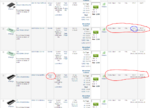T
treez
Guest
Please can you confirm that the 1206 resistor of the "LRMA" series cannot really dissipate the 1W that it says it can, without being soldered to a PCB with multiple cooling copper planes, including a significant "same side " cooling copper plane?
https://www.welwyn-tt.com/pdf/datasheet/LRMA.pdf
https://www.welwyn-tt.com/pdf/datasheet/LRMA.pdf
Last edited by a moderator:
